AMD Radeon HD 7790 Review Feat. Sapphire: The First Desktop Sea Islands
by Ryan Smith on March 22, 2013 12:01 AM EST- Posted in
- GPUs
- AMD
- Sapphire
- GCN
- Radeon HD 7000
Power, Temperature, & Noise
Last but not least of course is our look at power, temperature, and noise. AMD designed the Bonaire GPU in the same vein as Cape Verde, making it slightly bigger and slightly more power hungry, but not immensely so. As a result of this and other considerations the 7790’s typical board power is rated at 85W, just 5W over the 7770’s. Now we’ll see how that translates to real world conditions.
Stopping quickly to take a look at voltages, while AMD’s clock averaging algorithm means that we cannot see the individual states, we can still see the idle and top states just as before due to the fact that these are easily sustained states. So we know what kind of voltage our 7790 reference card is pulling at idle and at 1GHz. To that end we’re seeing a idle voltage of 0.894v and a load voltage of 1.263v according to GPU-Z.
| Radeon HD 7790 Voltages | ||||
| Ref 7790 Idle | Ref 7790 Load | Sapphire 7790 Load | ||
| 0.894v | 1.263v | 1.263v | ||
For anyone curious about the impact of the latest rendition of PowerTune, we also recorded the average (average) clockspeed of the 7790 in all of our games. Since PowerTune in this case is being used purely as a throttling mechanism and not as a boost mechanism, there’s actually very little to report here. Our 7790 sustained 1GHz in each and every game. Even in FurMark the average clockspeed was only slightly reduced, to 975MHz. Given what we’re seeing, we don’t see any reason that any other 7790 card shoudn’t be doing the full 1GHz the vast majority of the time.
| Radeon HD 7790 Average Clockspeeds | |||
| Base Clockspeed | 1000MHz | ||
| DiRT:S | 1000MHz | ||
| Shogun 2 | 1000MHz | ||
| Hitman | 1000MHz | ||
| Sleeping Dogs | 1000MHz | ||
| Crysis | 1000MHz | ||
| Far Cry 3 | 1000MHz | ||
| Battlefield 3 | 1000MHz | ||
| Civilization V | 1000MHz | ||
| FurMark | 975MHz | ||
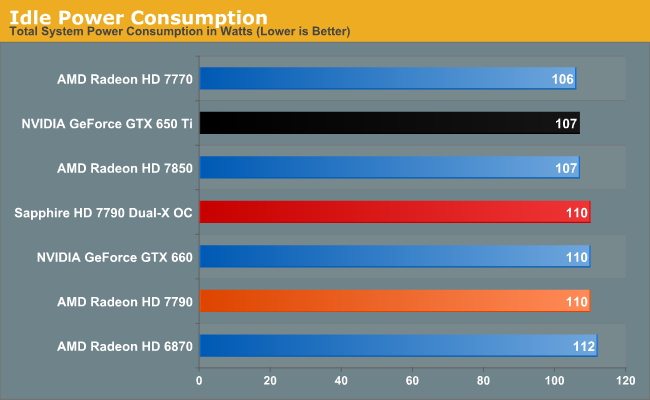
Kicking things off as always is our look at power consumption. We are measuring power consumption at the wall for the entire system, so these numbers are almost entirely composed of everything but the video card, but it still is sensitive enough to identify any cards that may be significantly worse than today’s low-idling cards.
For reasons we’re not entirely sure of, we’re seeing 7790’s idle power consumption come in at just a bit higher than both the 7770 and 7850. As Bonaire is a larger GPU the former isn’t unusual, but it’s not clear why 7790 is pulling more power at idle than the larger yet 7850 and its 2GB of GDDR5. The difference at the wall is only a couple of watts, but it is repeatable.

Looking at our first load power test with Battlefield 3, we can see that our test results are very close to AMD’s typical board power rating. Both the reference and Sapphire 7790 cards are pulling 7W more than the 7770, a hair more than the 5W difference in AMD’s TBP. Considering the fact that the 7790 is nearly 30% faster than the 7770 on average, this is quite an accomplishment on a power/performance basis for AMD in the span of a year. It’s a very reasonable increase in performance for very little of an increase in power consumption. This also means that the 7790 looks good against the 7850; the 7850 is faster, but it draws 22W more at the wall.
But perhaps more interesting is the 7790 against the GTX 650 Ti. The 650 Ti is around 5% faster in this test, but it’s also leading to our testbed drawing 12W more at the wall. As BF3 is a game test, power consumption does scale slightly with performance due to the extra work put on the CPU to generate the additional frames, but a 5% performance difference in this case would not explain a 12W increase in power consumption. NVIDIA has for a long time set the bar on efficiency, but with the 7790 it looks like AMD will finally edge out NVIDIA.
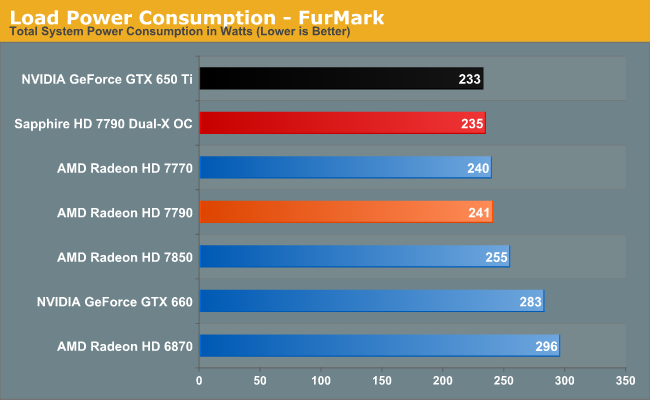
Moving on to FurMark the picture changes a bit. Against the 7770 the 7790 once again looks great, with the difference at the wall being a single watt, while drawing 14W less than the 7850. On the other hand the 7790 is now drawing slightly more than the GTX 650 Ti, but as we’ve see before game tests and FurMark can sometimes be at odd since FurMark is an explicit test of a card’s power throttling systems. NVIDIA looks to be throttling a bit harder than AMD, which would lead to what we’re seeing.
At the same time our 7790 cards show a bit of variance. The Sapphire card, despite being overclocked, draws 6W less than our reference 7790. There are some temperature differences between the cards due to their different coolers, so with the new PowerTune this may be a manifestation of the impact of power. Or it could just be standard variation for 7790, taking into consideration that the GPU in the Sapphire card would be binned. In FurMark this is mostly an intellectual curiosity. Once we have more 7790s we may be able to break it down further.
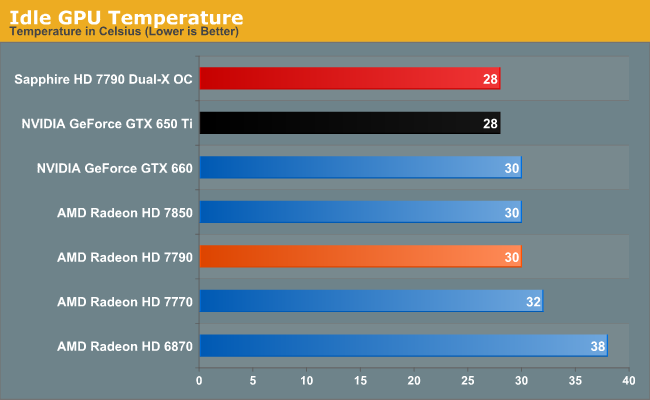
Looking at idle temperatures there are no great surprises here. Sapphire’s Dual-X cooler can bring their card down to 28C, while our reference card hits 30C. Idle temperatures on these low-wattage GPUs aren’t too far above room temperature.
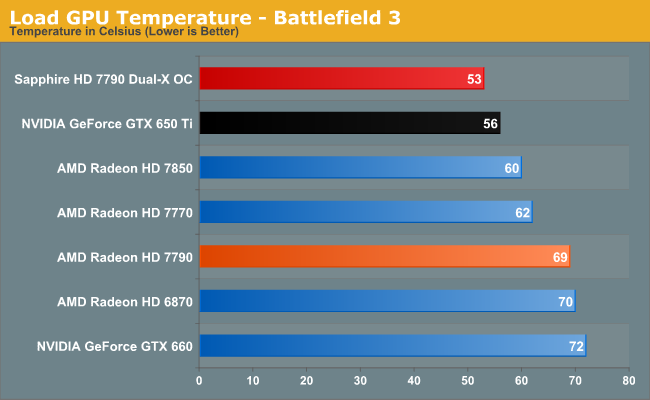
Jumping to load temperatures, the reference 7790 with its admittedly average cooler is particularly average in the temperature department. 69C is warmer than the 7850, 7770, and the GTX 650 Ti, but as it’s still under 70C these are by all considerations still cool temperatures. Sapphire’s cooler in the meantime looks very good here. 53C when running BF3 is quite an accomplishment, especially since our reference GTX 650 Ti does so well in this test.
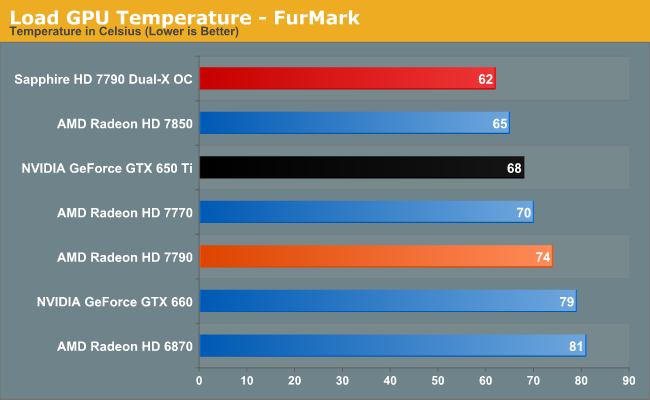
Cranking things up to the max for FurMark, we can see that temperatures are up across the board. The reference 7790 is now at 74C, which is warm but not exceptional. It’s still a low enough power card that even a half-decent cooler is enough to render temperatures meaningless. Meanwhile Sapphire’s card once again takes top honors at a relatively chilly 62C, 3C cooler than the otherwise overbuilt 7850, and 6C cooler than the reference GTX 650 Ti.
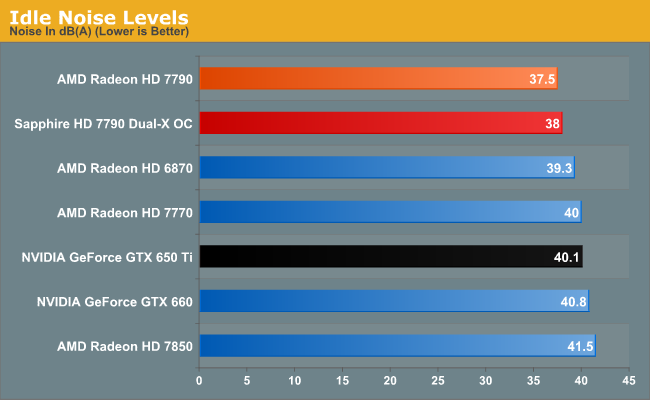
Both of our 7790 cards look good when it comes to idle noise. The reference 7790 with its one fan runs up against the noise floor at 37.5 dB(A), while the Sapphire card with its two fans is just a bit louder at 38 dB(A). In lieu of passive cooling this looks like a decent option for silent PC enthusiasts looking for a quiet idle, though really anything at the GTX 650 Ti level or lower is doing rather well here.
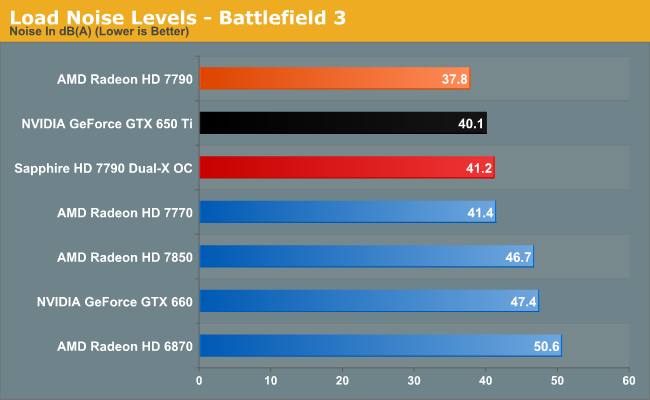
Jumping into load noise, we can see that the reference 7790 and its simple open air cooler thrives with our BF3 testing. Despite the jump in heat dissipation the amount of noise generated by its one fan has jumped by less than 1 dB(A), an almost imperceptible increase. At the same time this paints a picture of the reference 7790 where it looks like it has been optimized for noise over temperature, giving us reasonably acceptable temperatures for fantastic acoustics.
Sapphire’s card on the other hand isn’t set to favor acoustics over temperature, so those great temperatures we saw earlier do come at the expense of some noise. 41.2 dB(A) leaves it effectively tied with the 7770 and quite a bit quieter than the 7850, but over 3 dB(A) louder than the reference 7790, and 2 dB(A) louder than the GTX 650 Ti. If you’re looking for near-absolute silence here there is a clear benefit to the reference 7790 over Sapphire’s card, but 41.2 dB(A) is nothing to sneeze at.
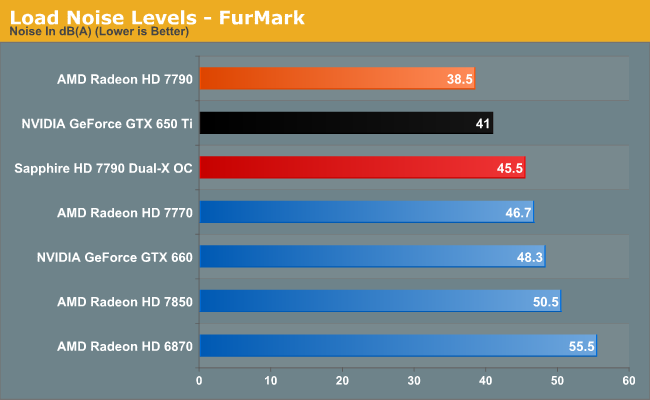
Finally we have our look at noise under FurMark. Again the reference 7790 does very well here, coming in at 38.5 dB(A), amazingly quiet for a >75W card under FurMark. This is over 8 dB(A) quieter than the 7770, 12 dB(A) quieter than the 7850, and over 2 dB(A) quieter than the GTX 650 Ti. AMD is more interested in pushing partner cards than their own design, but right now right here the reference design is looking very good.
As for Sapphire’s card, once more we see it favoring temperatures over noise. 45.5 dB(A) is still quieter than the reference 7770, so Sapphire isn’t doing badly here. But the reference 7790 and even the GTX 650 Ti back it into a corner. If you care about noise than the reference 7790 is a better configuration, but if you care about temperature the Sapphire is going to be a tough act to beat.
It goes without saying of course that these noise improvements come despite a 30%+ increase in performance over the 7770, and contrast against a marginal increase in power consumption. The price difference between the 7770 and 7790 put them in distinctly different categories, but the 7790s we’re seeing are clear improvements over the 7770 in practically every way. These gains aren’t quite as remarkable when placed against the GTX 650 Ti due to the latter’s high efficiency out of the gate, however that doesn’t mean AMD hasn’t managed to surpass NVIDIA here. BF3 power consumption and noise testing on our reference 7790 tells us that AMD can edge out NVIDIA in the efficiency department here, especially since this comes with a 10% performance improvement.










107 Comments
View All Comments
Spunjji - Friday, March 22, 2013 - link
...forgive my stupidity. Actual figures of the 7790 here:http://www.techpowerup.com/reviews/Sapphire/HD_779...
Depends on whether we focus on Peak / Max figures to decide whether you or I am closer to the truth. :)
Ryan Smith - Friday, March 22, 2013 - link
Typical Board Power, not Total. TBP is an average rather than a peak like TDP, which is why it's a lower number than TDP.dbcoopernz - Friday, March 22, 2013 - link
Any details on UVD module? Any changes?The Asus Direct Cu-II might make an interesting high power but quiet HTPC card. Any chance of a review?
Ryan Smith - Friday, March 22, 2013 - link
There are no changes that we have been made aware of.haplo602 - Friday, March 22, 2013 - link
somebody please make this a single slot card and I am sold ... otherwise I'll wait for the 8k radeons ...Shut up and drink - Friday, March 22, 2013 - link
Has it occurred to anyone else that this is in all probability an OEM release of the "semi-custom" silicon that will find its way into Sony's Playstation 4 in the fall?Word has it that Sony has some form of GPU switching tech integrated into the PS4.
- apologies for the link to something other than Anand but I don't think they ran anything on the story http://www.tomshardware.com/news/sony-ps4-patent-p...
Initially I presumed this to be some "Optimus"-esque dynamic context switching power saving routine. However, the patent explicitly states, "This architecture lets a user run one or more GPUs in parallel, but only for the purpose of increasing performance, not to reduce power consumption."
Which struck me as some kind of expansion on the nebulous "hybrid crossfire" tech that AMD has been playing w/since they birthed the 3000 series 780G igpu
Based off of AMD's previous endeavors in this area on the PC side I would be skeptical of the benefits/merit of pairing the comparatively anemic iGPU's of Kabini w/a presumably Bonaire derived GPU.
As an aside; since SLI/CFX work by issuing frames to the next GPU available, if one GPU is substantially faster than the other(s), frames get finished out-of-order and the IGP/slower-GPU's tardy frames simply get dropped which may make the final rendered video stuttery/choppy.
Pairing an IGP with a disproportionately powerful discrete GPU simply does not work for realtime rendering.
It is certainly possible that with the static nature of the console and perhaps especially the unified nature of the GDDR5 memory pool/bank that performance gains could be had
However, my digression on the merits of the tech thus far is
128 + 128 = 256 + 896 = Anand's own deduction of 1152sp's)
Shut up and drink - Friday, March 22, 2013 - link
I pushed submit by mistake...damn...oh well...my last point of arithmetic was simply that 1 fully enabled 4 core Kabini's I'm suspecting would have a 128 shader count igpu. Factor in the much ballyhooed 8-core Cpu in the PS4 we would have two Kabini's (128+128=256) + a Bonaire derived 896sp GPU all on some kind of custom MCM style packaging "semi-custom APU" (rumor had it that the majority of Sony's R&D contributions were in the stacking/packaging dept.)
Anyone concur?
Shut up and drink - Friday, March 22, 2013 - link
...which jives w/Anand's own piece that ran on the console's unveiling, "Sony claims the GPU features 18 compute units, which if this is GCN based we'd be looking at 1152 SPs and 72 texture units"http://www.anandtech.com/show/6770/sony-announces-...
A5 - Friday, March 22, 2013 - link
Yeah, once this came in at 14 CUs with minor architecture changes, it seemed like a likely scenario to me.Obviously it isn't going to give you PS4 performance on ports with only 1GB of memory, though.
crimson117 - Friday, March 22, 2013 - link
Good thought, but I sure hope Sony doesn't hamstring its PS4 with a 128-bit memory bus!